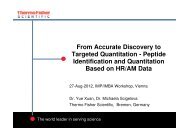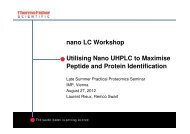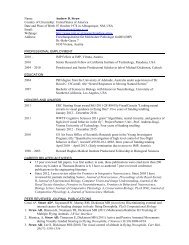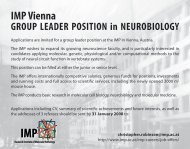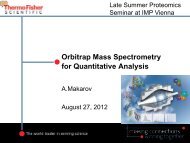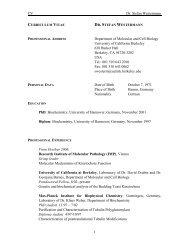IMP Research Report 2002
IMP Research Report 2002
IMP Research Report 2002
You also want an ePaper? Increase the reach of your titles
YUMPU automatically turns print PDFs into web optimized ePapers that Google loves.
Figure 1: (A) EGF-rhodamine was internalized for 24 hrs<br />
in Caco-2 cells, stably transfected with EGFP-p14. Living<br />
cells were observed under a confocal microscope. After<br />
24 hrs internalization the EGFP-p14 containing<br />
comparment was filled with EGF-rhodamine.<br />
(B) Schematic representation of the intracellular routes<br />
taken by the activated EGF-receptor and the p14/MP1/<br />
MAP kinase complex on late endosomes.<br />
(C) Overexpression of p14 in the adult eye of Drosphila.<br />
Left pair of panels (light microscopy/scanning electron<br />
microscopy): wild type; right pair of panels: Sev-Gal4/<br />
UAS-p14.<br />
In addition, ectopic expression of p14 in photoreceptor<br />
cells results in rough eyes (Figure 1), and, using<br />
antibodies against phosphorylated Erk we could<br />
correlate this phenotype with an over-activation of<br />
MAPK.<br />
TIS7 and SIN3 HDAC complex<br />
Mammalian histone deacetylases HDAC1 and HDAC2<br />
are members of the multisubunit SIN3 complex,<br />
containing also transcriptional co-repressors Sin3A and<br />
Sin3B, nuclear co-receptor N-CoR, several associated<br />
polypeptides like SAP30, and other, so far unidentified<br />
proteins. This year we have shown that the mouse TIS7<br />
protein is a novel transcriptional co-repressor that<br />
associates with the SIN3 complex. We have identified<br />
TIS7 as a gene that is upregulated upon loss of polarity<br />
in EpH4 cell line - TIS7 protein levels increase and the<br />
protein translocates into the nucleus. Overexpression<br />
of TIS7 causes loss of polarity and represses a<br />
restrictive set of genes, as revealed by cDNA microarray<br />
analysis. To investigate the molecular mechanism of<br />
TIS7-mediated transcriptional repression, yeast twohybrid<br />
screen and co-immunoprecipitations were<br />
performed. In EpH4 cells, TIS7 protein interacts with<br />
several proteins of the SIN3 complex, including mSin3B,<br />
the histone deacetylase HDAC1, nuclear receptor corepressor<br />
N-CoR and SAP30. The coimmunoprecipitated<br />
HDAC complex is enzymatically<br />
active. TIS7 targeted to a GAL4-dependent reporter<br />
represses transcription. Finally, we have demonstrated<br />
that the transcriptional repression of endogenous genes<br />
by TIS7 overexpression is HDAC dependent. Thus, we<br />
propose that TIS7 is a transcriptional co-repressor<br />
affecting the expression of specific genes in a HDAC<br />
activity-dependent manner during cell fate decisions,<br />
e.g. scattering. Currently, we are functionally<br />
characterizing a gene highly related to TIS7 that we<br />
have recently cloned, mSKMC15, which has 88%<br />
homology with TIS7 at the amino acid level. We have<br />
embarked on the knockout of both genes in mice.<br />
Contact: lukas.a.huber@uibk.ac.at<br />
New address: Dept. of Histology and Molecular Cell Biology<br />
Institute of Anatomy, Histology and Embryology<br />
University of Innsbruck, Medical School<br />
Muellerstrasse 59<br />
A-6020 Innsbruck - Austria<br />
Figure 2: Identification of TIS7 downstreamn target genes<br />
by cDNA microarray analysis: genes regulated differentially<br />
by TIS7 or the vector CELO, and vector-associated<br />
alterations only. All expression data can be viewed and<br />
downloaded via the web-browser at http://<br />
www.imp.univie.ac.at/lh/chip_10_5_01/index.html. On the<br />
left, the intensities of hybridization signals from control (0),<br />
Celo-eGFP and Celo-TIS7 infected cells are shown,<br />
respectively. On the right, the ratio between the signal in<br />
Celo-TIS7 and Celo-eGFP samples is shown. The results<br />
were confirmed using “Light cycler” real-time PCR analysis.<br />
CRABP II, cellular retionic acid binding protein; OPN,<br />
osteopontin; EBP, emopamil binding protein; MP0P, myelin<br />
protein 0 precursor.<br />
25




